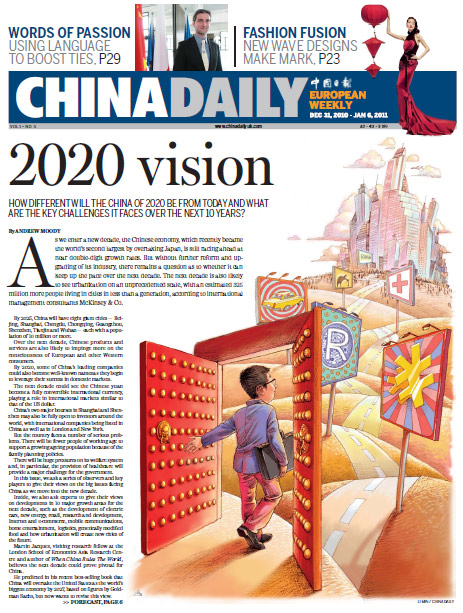Marketers tuned in to TV habits
Updated: 2007-07-30 12:39
(WSJ)
http://online.wsj.com/public/article/SB118574671889881610-quYu2upgMHCNTcF4j49fJN2_fhc_20070805.html?mod=regionallinks
SHANGHAI -- For most market researchers, China's vast interior has long been uncharted territory. But that is starting to change, as economic ripples from the country's booming cities create wealthier rural consumers -- and draw attention from companies and their ad agencies.
Less than two years ago, AGB Nielsen Media, which tracks TV-viewing habits outside the US, monitored audiences in 11 of China's biggest cities, including Beijing, Shanghai and Guangzhou. It wasn't even interested in villagers who lived on the outskirts of these metropolises.
Today, it has nearly 10,000 "people meters," which gather data on who is watching what and when, across a much broader area, including rural parts of Liaoning province in the northeast and Sichuan province in the southwest. The meters cover 56 million city dwellers and 315 million "nonurban" Chinese.
One insight: Nonurban people watch more television during the daytime, compared with people in big cities; researchers hadn't fully grasped that, AGB Nielsen says. In part, that is because farmers and shopkeepers are more likely to come home for lunch, researchers say.
For companies such as Procter & Gamble and Coca-Cola, which are looking to widen their reach in China, that is important information, allowing them to potentially reach more people, while spending less ad money by buying cheaper daytime commercial slots.
"If you decide not to measure those outside of the city, you are losing two-thirds of the population as they watch TV," says Alberto Colussi, chairman of AGB Nielsen's management board.
As the spending power of China's rural population grows, that is a serious oversight. According to AGB Nielsen, in the areas it covers today, 31.6 million urban homes have a monthly income of 1,500 yuan ($198) or more, while in the nonurban areas there are 31.3 million homes in that bracket.
Gathering data on rural Chinese can be difficult and costly. There are sharp differences in regional tastes and habits, making it hazardous to generalize. Even the languages spoken from one part of the country to another vary widely.
But as consumer-product manufacturers and other companies push into less-developed markets, market-data firms are working harder to fill knowledge gaps.
AGB Nielsen plans to double its number of meters and expand coverage to 16 provinces and cities representing 870 million viewers before the 2008 Beijing Olympics. The cost of adding meters means the company won't be profitable in China for now, says Mr. Colussi. Still, he says, it is essential.
AGB Nielsen's main competitor in China, CSM Media Research, a joint venture between China's CTR Market Research and London-based market-data and information company TNS Group, collects data from 45,000 homes, representing 1.19 billion viewers in China.
CSM Media uses people meters for major urban households. In smaller cities and villages, the company generally has viewers fill out a daily journal, which is less expensive but can be less accurate. As the TV ad markets in these smaller localities grow, the company is replacing journals with meters.
Advertisers are willing to pay more for better data as China's economy grows, says Mark Patterson, chief operating officer for GroupM Asia Pacific. GroupM, the media-buying arm of WPP Group, is the world's biggest ad-space buyer, and spends $1.4 billion a year in China.
GroupM expects the ad market in China to grow to 184.98 billion yuan this year, up from 155.76 billion yuan in 2006. About 70% of the spending will go for TV ads. Next year, industry analysts estimate, the Beijing Olympics will give the ad market an additional 30% boost.
Since reliable data are scarce outside big cities, Mr. Patterson says, "we have to do our own crude research as well. We deep-dive into certain Chinese cities to learn about Chinese viewing habits" through household interviews. GroupM also buys ratings data from both AGB Nielsen and CSM.
Using data from multiple sources can help, says Glen Murphy, managing director for ACNielsen China, which does market research for clients on a project basis and also compiles store-sales data.
"There isn't an established long-term discipline around collecting and using information throughout the country. So, if you compare it to the U.S., where the economy is well-developed and they have an 80-year history of measuring and collecting information on what consumers are doing...that's all still developing in China," says Mr. Murphy.
ACNielsen has been surveying the China market for clients since 1983, but data collection in smaller cities can be a challenge. Unlike in major cities, few stores have electronic-sales data. ACNielsen researchers count stock in stores and collect purchase invoices at sample outlets. ACNielsen has doubled its staff to 1,600 in the past two years in China to expand monitoring, says Mr. Murphy.
Paper's Digest

Convertible yuan
The yuan is likely to be fully convertible and on the way to being one of the world's major currencies by 2020.
Fight against inflation
Words of passion
Euro vision
Specials

Internet aids luxury sales
More sophisticated Chinese consumers are surfing for luxury products on the Internet and a number of branded labels are ready to ride the wave.

Tobacco controls
An anti-smoking watchdog has criticized Chinese authorities for "making little progress" on enforcing tobacco controls.

Godfather of yachts
Traugott Kaminski claims he was the first person to bring the yacht culture to China seven years ago.
